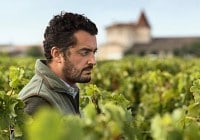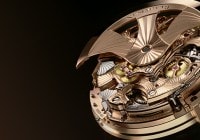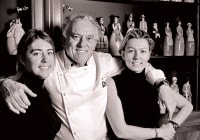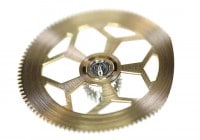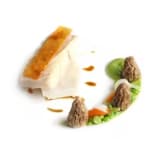
Search in Issues
Chapters
List of parts
Chapter 5
Return to the classics: MICHEL ROSTANG
There is unbounded joy in rediscovering the wonders of venerated French cuisine grand standards.
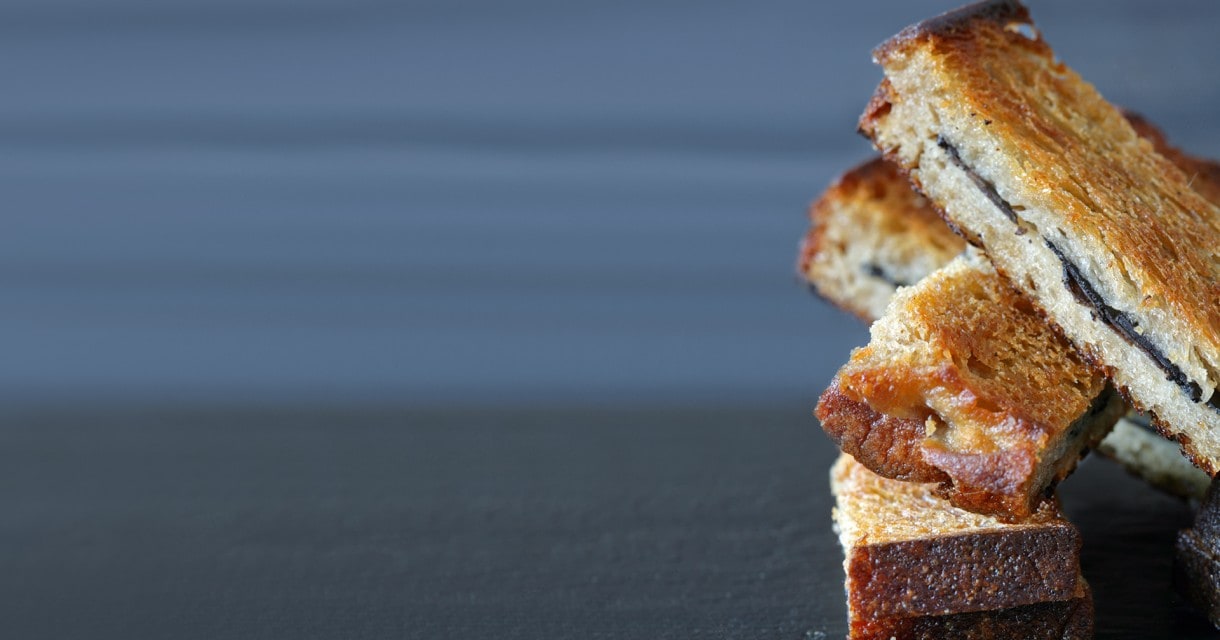
The teachings of Escoffier CAN BE SEEN AS FRESH, BOLD, AND MAYBE EVEN HIP in a world overrun with molecular cuisine.
It is undeniably true that there is thrill in discovery. Foodies and critics the world over summersault over ground breaking creations, exotic ingredients, molecular transformations, or whatever the fad du jour may thrust into the theatres which were formerly called restaurants. But what if the “discovery” is not at the cutting edge, is not the product of herb scavenging in the Norwegian forests, is not fashioned with a particle accelerator. In fact, what if it has been with us all along, just merely forgotten in the frenzied stampedes to unearth novelties? In short, what if the discovery is of grand classics, lovingly prepared, honed to perfection, cannot the thrill be the same, if not greater? Emphatically, “yes” and convincingly demonstrated during a recent return to Michel Rostang’s rue Rennequin Parisian restaurant which brought with it a reaffirmation of the pure pleasures and joys both of the traditional pillars of French cooking and the soothing rituals of table side presentation.
Indeed, we are not alone in this voyage of re-discovery of classical French cuisine. For those conditioned to visualize the evolution of gastronomy as progressing along an ever upward arc of audacity, there is growing evidence that perhaps cooking developments may bend in on themselves as with a Mobius strip. No less than the ever trendy and edgy New Yorker magazine devoted itself to a major article chronicling the recreation of three revered reference points of classic French cooking from recipes laid out as gospel by Escoffier—a chartreuse, a coulibiac of salmon and a canard au sang. Not only were the results revelations themselves, but the remarkably difficult task of preparing them proved to be an adventure. Surprise! Far from being passé, the teachings of Escoffier can be seen as fresh, bold, innovative, and maybe even hip in a world overrun with molecular cuisine
For Michel Rostang there is no re-discovery or re-invention of many of the venerable standards; they have been with him all along. Presiding at the stoves of the restaurant bearing his name since the 1970s and for 33 years, without interruption, carrying the accolade of two Michelin stars, he has steadfastly maintained his fidelity to the grand classics.
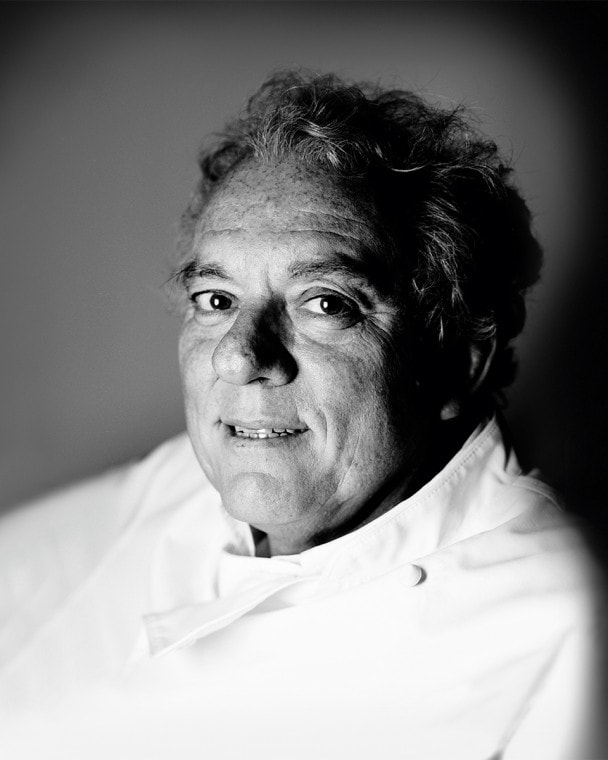
His roots are deep as there is a continuous line of grand chefs in his family; Michel is the fifth generation (and the third generation to have earned high accolades from the Michelin Guide). Rostang’s wife, Marie-Claude, who attends to the front of the house, as well hails from a family of chefs. Joining with her welcoming guests are their daughters, Sophie and Caroline, extending the restaurant generational line to six.
Like many grand chefs, Rostang’s training began early, at the age of 16, essentially at the same time as nouvelle cuisine began making headlines. Michel’s training, however, pointed in a different direction. His important sojourns were at Lasserre and Lucas Carton in Paris and La Marée in Biarritz, all temples of grand tradition. Together with sensibilities and inspirations from his father, Jo, Rostang emerged with a deep respect for and devotion to the defining principles of grand French cooking: a unified conception of a dish, sauces based on reductions, and, in contrast with today’s modernists, absence of fear of butter and cream. Hand in hand with these axioms which guide in the kitchen is his fidelity to the long celebrated, and tragically nearly forgotten, rituals of tableside presentation, carving, and serving. Rostang’s passion for tradition runs so deep that he eagerly collects 18th century cookbooks, often searching for them in forgotten corners of Paris’ renowned flea market, the Marché aux Puces. This is not to say that Rostang only looks toward and is imprisoned by the past for he has evolved and adjusted his approaches to recipes over time.
As with the Mobius strip where seeking the frontiers brings one back to the origin, what is striking is that today where else can one find an undiluted grande cuisine experience with preparations adhering to core elements of traditional French cooking, presented with élan and savoir-faire tableside? So whereas modernists struggle to emerge from the pack with ever more edgy creations, Rostang, by staying steadfast, finds himself having achieved what the others so desperately crave, uniqueness, as he stands nearly alone as the singular destination in Paris, if not the world, to indulge in a full dose of the pleasures of tradition.
Rostang’s devotion to the grand rituals of French cuisine found a new forum in 2012. The occasion was the 100th anniversary dinner of the Dîners d’Épicure d’Escoffier de Paris. The theme for this special dinner was “from the kitchen, to the dining room with gestures and explanations”. For the first time this Escoffier dinner was prepared by four chefs working together:
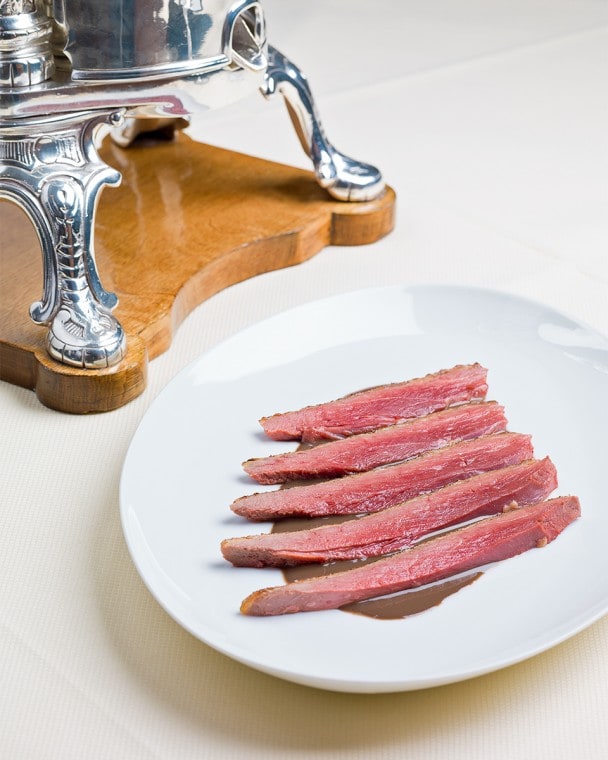
La canette “Miéral” au sang, servie saignante en deux services, sauce au vin rouge liée de son sang et au foie gras; salade de cuisses en fricassée.

L’araignée de mer relevée de gingembre, crémeux de courgettes en impression de caviar Osciètre.
One of ROSTANG’S GREAT SPECIALTIES is perfection in tableside preparation and service.
Michel Rostang, Michel Troisgros, Pierre Hermé and Jean-Pierre Biffi. Held at Rostang’s restaurant, the evening precipitated a frantic scramble by dedicated gourmets to snag a coveted seat in the dining room. Each of the chefs prepared one course of the meal. Rostang’s contribution to the evening was his preparation of canard au sang, which harmonized perfectly with the theme as it is a preparation that demands precision in the kitchen, followed by deft carving and preparation of the sauce in the dining room, accompanied by explanations as the tableside theater unfolds.
A recent visit to rue Rennequin emphatically served to confirm all that was right with this seemingly forgotten world. In vivid contrast with many of today’s eateries that inject hipness into the dining experience not only with what is on the plate but in the surroundings, Rostang confidently adheres to more time tested values. Passing the portal, one is immediately soothed by walls bathed in warm colored woods, softened still further with tapestries, well-chosen artwork, and a majestic vitrine filled with porcelain dolls. There is luxury in the arrangement of tables, each given abun- dant spacing from the others.
A small armada of preliminary bites is presented to accompany the traditional coupe de champagne: miniature sandwiches with a savory sardine mousse, madeleines with ham, a toast bearing a disk of lobster topped with just a dollop of pimento and finally an intense and classic pigeon mousse on a sablé crust. Not only are these perfect matches for the champagne, they ease the burden of traversing what is, without doubt, one of the finest wine lists in Paris. Rich and diverse the selection is particularly impressive in the depth and savvy choices of its Burgundy listings thanks to sommelier, Alain Ronzatti, who has presided over the cellar since 1987 and who not only possesses encyclopedic knowledge over its contents but delights in describing them.
Still in the repertoire and recalling vivid memories of our first visit to Rostang in the early 1980’s is the ravioles de Romans cuites au bouillon de volaille, cerfeuil frais. Ethereally light miniature raviolis are stuffed with a cheese mousse accented with chervil and floated in a doubly intense chervil infused chicken stock. Silky and light this is a perfect overture for the meal that follows.
Shellfish are a specialty with one towering preparation that has no equal, certainly in Paris, and likely the world, la salade de homard “bleu” cuit au moment servi entier, jeunes poireaux en vinaigrette, crémeux de homard et jus de la presse à la betterave. Dedicated foodies are no doubt at this point questioning the bona fides of this admittedly somewhat bold assertion of uniqueness; easy to vaporize those doubts with the further description. A cart with its cutting board bearing a whole cold water Brittany lobster in shell is wheeled tableside and becomes the stage for the theater that follows. Rostang is fiercely partial to the drama of dining room presentation and this lobster
The restaurant soothes the diner WITH ITS WARM WOOD WALLS.
preparation furnishes vivid proof both of its delights and the enormous talent and panache required to pull it off. With not a single false thrust of his knife, Maître d’hôtel, Bruno Grimault, deftly and perfectly dispatches with the carapace extracting completely intact each lukewarm section of the lobster. Where else is a whole lobster presented and “carved” tableside? But the drama does not end with carving. Once removed from the shell, the cooked, until just translucent, meat is composed into the salad as it is divided among twelve compartments on a mighty single platter, each containing the other elements of the salad: leeks, rich beet purée, lobster sauce. The unexpected pairing in the salad is that of sections of the lobster with the beetpurée. Without being cloying, the beet provides a delicate accent that amplifies the natural sweetness of the lobster. In every dimension, its precise cooking, unique tableside presentation and its salad pairings, this is a majestic dish that alone is worthy of a pilgrimage to Paris.
Rostang’s araignée de mer relevée de gingembre, crémeux de courgettes en impression de caviar Osciètre is a further demonstration of his shellfish talents. In less capable hands, spider crab dishes more often than not disappoint. The difficulty is that spider crab is extremely delicate and easily overpowered by its accompaniments; it demands restraint and refinement and that’s exactly what Rostang delivers. The courgettes take the form of a fine mousse enveloping the crab as a cannelloni. Not merely a vegetable cannelloni, this one is decorated with fine circles of caviar.
There is another specialty that may ignite a mob for the next flight to Charles de Gaulle airport, le sandwich tiède à la truffe fraîche, pain de campagne grillé et beurre salé. Think of this an everyday grilled cheese sandwich, with one key substitution. Out goes the cheese, in come the truffles. This is the ultimate in luxurious comfort food, simple, intense, and sinfully decadent. Rostang has developed one trick in the assembly of what otherwise might seem to be a trivially simple dish. He perfumes both the butter and bread with the truffles for three days before grilling and serving the sandwich, so that rather than having the toasted bread and butter serving as foils for the truffles, they contribute themselves to the heady aromas and flavor.
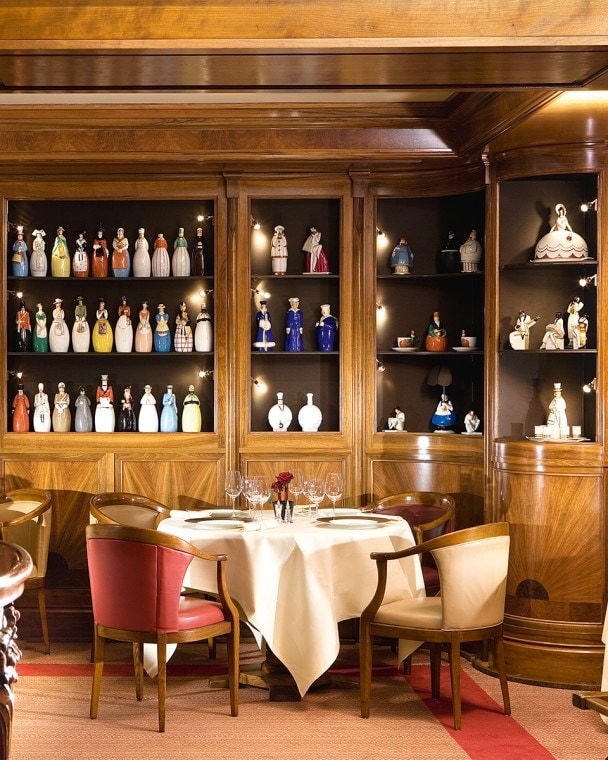
A nearly forgotten staple of grand French cuisine still reins supreme on rue Rennequin, la quenelle de brochet soufflée à la crème de homard. The first forkful is nearly certain to launch cascades of regrets for the decades that the food world has let pass with classic quenelles all but banned from restaurant menus. Of course it is rich. Defiantly so. But do we not go to grand restaurants to escape our everyday lives and indulge in decadent pleasure? Somehow the idea that every meal, even a special night out, should ape spa food has come to monopolize the thinking of chefs and patrons alike. These quenelles, actually served as a single large quenelle soufflée, accompanied by an intense, rich, deeply flavored lobster sauce, plainly enhanced by cooking with the shell, convincingly banishes whatever politically correct thoughts of lean cuisine that might otherwise pop into one’s head. No decoding, no thinking required as each morsel triggers waves of pleasure.
Lighter, and in today’s idiom, more conventional, is le tronçon de turbot rôti, jeunes carottes et morilles fraîches, coques d’oignons glacés et jus des arêtes au vin de Syrah. Simply roasted the sparkling fresh turbot is poised next to a fresh pea “boat” bearing the carrots, onions and mushrooms.
Bruno Grimault’s tableside élan and flourishes are in full flight with la canette “Miéral” au sang, servie sai- gnante en deux services, sauce au vin rouge liée de son sang et au foie gras; salade de cuisses en fricassée, the dish for which Rostang, world-wide, is most renown. It is difficult to find restaurants that have maintained the savoir-faire for either the cooking or dining room carving of a whole roast duck which only enhances the appreciation for the milimetric precision of the cooking to hit that perfect rare point and for Bruno Grimault’s flawless carving of the gleaming mahogany-colored fowl. But the tableside slicing is only the first act of a two act play as it is followed by the final preparation of the sauce. The finishing of the sauce depends upon an apparatus that today is nearly impossible to find, a silver duck press. As the first step of the sauce preparation, the duck carcass is placed into the towering press to extract its precious juices. Working quickly, the juices are combined with the sauce base and reduced over a hot flame; the result a thick, dark, spicy, profoundly deep sauce.
There has been one change in the presentation which has taken place over the past few years. Previously the rare duck breasts were carved into nearly paper thin slices, cutting from front to back on the breasts, and poised on the plate in a fashion somewhat resembling a carpaccio. To bring a bit more chew into every bite, Rostang now offers the slices, cut somewhat thicker and oriented from the outside of the breast inward. Over the years having enjoyed both, there is no wrong answer. With both methods the duck is ethereal, ten- der with just that trace of chew that Rostang sought with the modified carving method, and bathed in the decadently rich powerful sauce. There is a reason Escoffier prescribed all the details for preparing canard au sang including the duck press, as without its contribution to the sauce the full glory of the recipe would
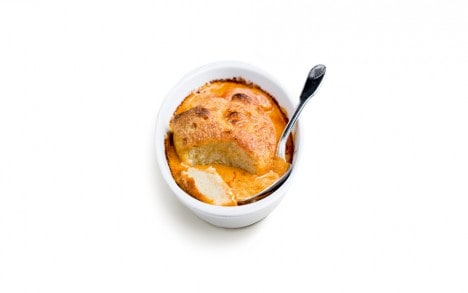
La quenelle de brochet soufflée à la crème de homard.
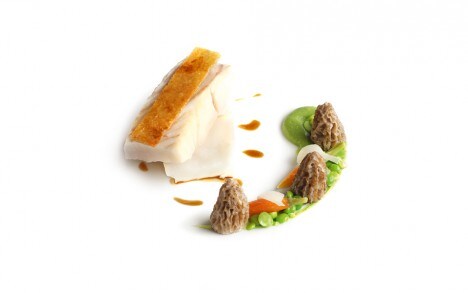
Le tronçon de turbot rôti, jeunes carottes et morilles fraîches, coques d’oignons glacés et jus des arêtes au vin de Syrah.
be lost. And equally its inclusion in the 100th anniversary Escoffier dinner was at once obvious and obligatory as this dish, with Rostang’s skills, is truly one of the fundamental pillars of grand French cuisine. And punctuating the message that one is not dining in a spa, but rather indulging in a true fête, served alongside the duck is a sinful potato gratin.
Impressive is la noix de ris de veau croustillante aux écrevisses, fanes de navets farcies d’une crème de persil et champignons de Paris. For his sweetbreads, Rostang adheres to classicism. Sweetbreads are always a test of a kitchen’s mastery of technique; done correctly, which sadly does not often occur, there should be an intriguing texture contrast between the exterior and interior, a crispy crust and a delicately creamy interior. Rostang achieves that result perfectly. The pairing with crayfish sauce is both traditional and magnificent.
Le soufflé chaud au caramel beurre salé, sorbet aux “poires Williams” is a perenial favorite at Rostang. Although the description appears to tread on familiar ground, Rostang brings a few twists of his own. For the soufflé itself, the salty caramel base is given both texture and depth with the addition of hazelnuts. Even more surprises lurk with the accompanying pear sorbet which is given an exotic racy kick with Szechuan pepper. And if you are partial to salty caramel sauces, his preparation begs for a carafe sized serving.
Rue Rennequin has been a personal destination in Paris for three decades. There is comfort in finding Michel Rostang honoring and respecting the same values that catapulted him to fame at the beginning of his career. And for those who revel in the delights of grand French cuisine or for those who in the rush for modernity skipped past and have ground to make up, rue Rennequin beckons as an oasis in Paris.
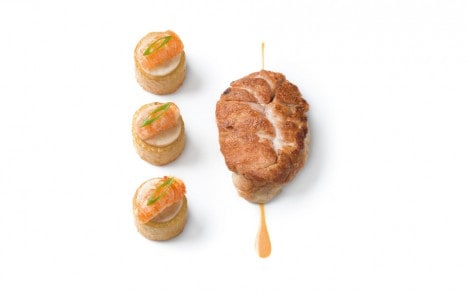
La noix de ris de veau croustillante aux écrevisses, fanes de navets farcies d’une crème de persil et champignons de Paris.

Le soufflé chaud au caramel beurre salé, sorbet aux “poires Williams”.
Other issues
Don't miss the latest issue
Sign Up for New Releases


